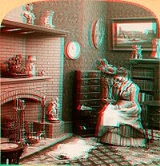
Anaglyph image
Encyclopedia

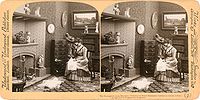
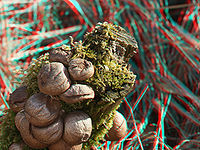

Anaglyph images are used to provide a stereoscopic
Stereoscopy
Stereoscopy refers to a technique for creating or enhancing the illusion of depth in an image by presenting two offset images separately to the left and right eye of the viewer. Both of these 2-D offset images are then combined in the brain to give the perception of 3-D depth...
3D effect, when viewed with glasses where the two lenses are different (usually chromatically opposite) colors, such as red
Red
Red is any of a number of similar colors evoked by light consisting predominantly of the longest wavelengths of light discernible by the human eye, in the wavelength range of roughly 630–740 nm. Longer wavelengths than this are called infrared , and cannot be seen by the naked eye...
and cyan
Cyan
Cyan from , transliterated: kýanos, meaning "dark blue substance") may be used as the name of any of a number of colors in the blue/green range of the spectrum. In reference to the visible spectrum cyan is used to refer to the color obtained by mixing equal amounts of green and blue light or the...
. Images are made up of two color layers, superimposed, but offset with respect to each other to produce a depth effect. Usually the main subject is in the center, while the foreground and background are shifted laterally in opposite directions. The picture contains two differently filtered colored images, one for each eye. When viewed through the "color coded" "anaglyph glasses", they reveal an integrated stereoscopic image
Stereoscopy
Stereoscopy refers to a technique for creating or enhancing the illusion of depth in an image by presenting two offset images separately to the left and right eye of the viewer. Both of these 2-D offset images are then combined in the brain to give the perception of 3-D depth...
. The visual cortex
Visual cortex
The visual cortex of the brain is the part of the cerebral cortex responsible for processing visual information. It is located in the occipital lobe, in the back of the brain....
of the brain fuses this into perception of a three dimensional scene or composition.
Anaglyph images have seen a recent resurgence due to the presentation of images and video on the Internet
Internet
The Internet is a global system of interconnected computer networks that use the standard Internet protocol suite to serve billions of users worldwide...
, Blu-ray Disc
Blu-ray Disc
Blu-ray Disc is an optical disc storage medium designed to supersede the DVD format. The plastic disc is 120 mm in diameter and 1.2 mm thick, the same size as DVDs and CDs. Blu-ray Discs contain 25 GB per layer, with dual layer discs being the norm for feature-length video discs...
s, CDs, and even in print. Low cost paper frames or plastic-framed glasses
Glasses
Glasses, also known as eyeglasses , spectacles or simply specs , are frames bearing lenses worn in front of the eyes. They are normally used for vision correction or eye protection. Safety glasses are a kind of eye protection against flying debris or against visible and near visible light or...
hold accurate color filters that typically, after 2002, make use of all 3 primary colors. The current norm is red
Red
Red is any of a number of similar colors evoked by light consisting predominantly of the longest wavelengths of light discernible by the human eye, in the wavelength range of roughly 630–740 nm. Longer wavelengths than this are called infrared , and cannot be seen by the naked eye...
and cyan
Cyan
Cyan from , transliterated: kýanos, meaning "dark blue substance") may be used as the name of any of a number of colors in the blue/green range of the spectrum. In reference to the visible spectrum cyan is used to refer to the color obtained by mixing equal amounts of green and blue light or the...
, with red being used for the left channel. The cheaper filter material used in the monochromatic past dictated red and blue for convenience and cost. There is a material improvement of full color images, with the cyan filter, especially for accurate skin tones.
Video games, theatrical films, and DVDs can be shown in the anaglyph 3D process. Practical images, for science or design, where depth perception is useful, include the presentation of full scale and microscopic stereographic images. Examples from NASA
NASA
The National Aeronautics and Space Administration is the agency of the United States government that is responsible for the nation's civilian space program and for aeronautics and aerospace research...
include Mars Rover
Mars Rover
A Mars rover is an automated motor vehicle which propels itself across the surface of the planet Mars after landing.Rovers have several advantages over stationary landers: they examine more territory, they can be directed to interesting features, they can place themselves in sunny positions to...
imaging, and the solar investigation, called STEREO
STEREO
STEREO is a solar observation mission. Two nearly identical spacecraft were launched into orbits that cause them to respectively pull farther ahead of and fall gradually behind the Earth...
, which uses two orbital vehicles to obtain the 3D images of the sun. Other applications include geological illustrations by the United States Geological Survey
United States Geological Survey
The United States Geological Survey is a scientific agency of the United States government. The scientists of the USGS study the landscape of the United States, its natural resources, and the natural hazards that threaten it. The organization has four major science disciplines, concerning biology,...
, and various online museum objects. A recent application is for stereo imaging of the heart using 3D ultra-sound with plastic red/cyan glasses.
Anaglyph images are much easier to view than either parallel (diverging) or crossed-view pairs stereogram
Stereogram
A stereogram is pair of two-dimensional panels depicting the view of a scene or an object from the vantage points of the right and left eyes. Observing the panels superimposed in a stereoscope results in the experience of three-dimensionality by virtue of the fact that object depth is encoded as...
s. However, these side-by-side types offer bright and accurate color rendering, not easily achieved with anaglyphs. Recently, cross-view prismatic glasses with adjustable masking have appeared, that offer a wider image on the new HD video and computer monitors.
History
The first method to produce anaglyph images was developed in 1853 by Wilhelm Rollmann in Leipzig, Germany.Producing anaglyph images
In historical methods using camera filters, on film, two images from the perspective of the left and right eyes were projected or printed together as a single image, one side through a redRed
Red is any of a number of similar colors evoked by light consisting predominantly of the longest wavelengths of light discernible by the human eye, in the wavelength range of roughly 630–740 nm. Longer wavelengths than this are called infrared , and cannot be seen by the naked eye...
filter and the other side through a contrasting color such as blue
Blue
Blue is a colour, the perception of which is evoked by light having a spectrum dominated by energy with a wavelength of roughly 440–490 nm. It is considered one of the additive primary colours. On the HSV Colour Wheel, the complement of blue is yellow; that is, a colour corresponding to an equal...
or green
Green
Green is a color, the perception of which is evoked by light having a spectrum dominated by energy with a wavelength of roughly 520–570 nanometres. In the subtractive color system, it is not a primary color, but is created out of a mixture of yellow and blue, or yellow and cyan; it is considered...
or mixed cyan
Cyan
Cyan from , transliterated: kýanos, meaning "dark blue substance") may be used as the name of any of a number of colors in the blue/green range of the spectrum. In reference to the visible spectrum cyan is used to refer to the color obtained by mixing equal amounts of green and blue light or the...
. As outlined below, one may now, typically, use an image processing computer program
Digital image processing
Digital image processing is the use of computer algorithms to perform image processing on digital images. As a subcategory or field of digital signal processing, digital image processing has many advantages over analog image processing...
to simulate the effect of using color filters, using as a source image a pair of either color or monochrome images.
In the 1970s filmmaker Stephen Gibson filmed direct anaglyph blaxploitation
Blaxploitation
Blaxploitation or blacksploitation is a film genre which emerged in the United States circa 1970. It is considered an ethnic sub-genre of the general category of exploitation films. Blaxploitation films were originally made specifically for an urban black audience, although the genre's audience...
and adult movies. His "Deep Vision" system replaced the original camera lens with two color-filtered lens focussed on the same film frame. In the 1980s, Gibson patented his mechanism.
Popular professional programs such as Adobe Photoshop
Adobe Photoshop
Adobe Photoshop is a graphics editing program developed and published by Adobe Systems Incorporated.Adobe's 2003 "Creative Suite" rebranding led to Adobe Photoshop 8's renaming to Adobe Photoshop CS. Thus, Adobe Photoshop CS5 is the 12th major release of Adobe Photoshop...
provide the basic digital tools for processing of anaglyphs. They do not provide instruction for anaglyph in their basic documentation. Various websites offer free instruction related to 3D for Photoshop. Simple, low cost programs, dedicated to anaglyph creation, are also available. In recent simple practice, the left eye image is filtered to remove blue & green. The right eye image is filtered to remove red. The two images are usually positioned in the compositing phase in close overlay registration (of the main subject). In Photoshop, for example, a function called "screen" in the "layers" (F7) option allows the two filtered layers to be combined transparently on top of each other, although the compositing can also be done by pasting the selected channels. The filtration itself can easily be done in the "curves" function, which allows removal of any red, green, or blue layer with a simple slider. Experienced Photoshop users can sometime process a good cross-view 3D pair into a color anaglyph in 2 to 5 minutes if little fine-tuning is required. Various steps can also be used to maximize the quality of the result. These may include size matching of the frames to within a few pixels, rotation (if needed), gamma leveling, and digital sharpening of the softer red image. It should be noted that both the red layer in the image and the red filter in the glasses contain no visible blue or green color information, but masked colors do exist that the eyes cannot see through a red filter that can interact with the colors contained in the cyan image after compositing and blending.
There also exists a method for making anaglyphs, using only one image in combination with a depth map, that yields acceptable results.
How anaglyph works
Viewing anaglyphs through appropriately colored glasses results in each eye seeing a slightly different picture. In a red-blue anaglyph, for instance, the eye covered by the red filter sees the red parts of the image as "white", and the blue parts as "black" (with the brain providing some adaption for color); the eye covered by the blue filter perceives the opposite effect. True white or true black areas are perceived the same by each eye. The brain blends together the image it receives from each eye, and interprets the differences as being the result of different distances. This creates a normal stereograph image without requiring the viewer to cross his or her eyes.Viewing

Red sharpened anaglyph glasses
Simple paper, uncorrected gel glasses, cannot compensate for the 250 nanometer difference in the wave lengths of the red-cyan filters. With simple glasses, the red filtered image is somewhat blurry, when viewing a close computer screen or printed image. The (RED) retinal focus differs from the image through the (CYAN) filter, which dominates the eyes' focusing. Better quality, molded acrylic glasses frequently employ a compensating differential diopter power (a spherical correction) to balance the red filter focus shift relative to the cyan, which reduces the innate softness, and diffraction of red filtered light. Low power reading glasses worn along with the paper glasses also sharpen the image noticeably.The correction is only about 1/2 + diopter on the red lens. However, some people with corrective glasses are bothered by difference in lens diopters, as one image is a slightly larger magnification than the other. Though endorsed by many 3D websites, the diopter "fix" effect is still somewhat controversial. Some, especially the nearsighted, find it uncomfortable. There is about a 400% improvement in acuity with a molded diopter filter, and a noticeable improvement of contrast and blackness. The American Amblyopia
Amblyopia
Amblyopia, also known as lazy eye, is a disorder of the visual system that is characterized by a vision deficiency in an eye that is otherwise physically normal, or out of proportion to associated structural abnormalities of the eye...
Foundation uses this feature in their plastic glasses for school screening of children's vision, judging the greater clarity as a significant plus factor.
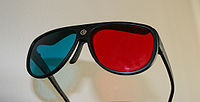
Anachrome filters
Plastic glasses, developed in recent years, provide both the diopter "fix" noted above, and a change in the cyan filter. The formula provides intentional "leakage" of a minimal (2%) percentage of red light with the conventional range of the filter. This assigns two-eyed "redness cues" to objects and details, such as lip color and red clothing, that are fused in the brain. Care must be taken, however, to closely overlay the red areas into near-perfect registration, or "ghosting" can occur. Anachrome formula lenses work well with black and white, but can provide excellent results when the glasses are used with conforming, "anachrome friendly" images. The US Geological SurveyUnited States Geological Survey
The United States Geological Survey is a scientific agency of the United States government. The scientists of the USGS study the landscape of the United States, its natural resources, and the natural hazards that threaten it. The organization has four major science disciplines, concerning biology,...
has thousands of these "conforming", full-color images, which depicts the geology and scenic features of the U.S. National Park system
National Park Service
The National Park Service is the U.S. federal agency that manages all national parks, many national monuments, and other conservation and historical properties with various title designations...
. By convention, anachrome images try to avoid excess separation of the cameras, and parallax
Parallax
Parallax is a displacement or difference in the apparent position of an object viewed along two different lines of sight, and is measured by the angle or semi-angle of inclination between those two lines. The term is derived from the Greek παράλλαξις , meaning "alteration"...
, thereby reducing the ghosting that the extra color bandwidth introduces to the images.
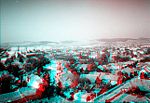
Traditional anaglyph processing methods

JPEG
In computing, JPEG . The degree of compression can be adjusted, allowing a selectable tradeoff between storage size and image quality. JPEG typically achieves 10:1 compression with little perceptible loss in image quality....
.

Adobe Photoshop
Adobe Photoshop is a graphics editing program developed and published by Adobe Systems Incorporated.Adobe's 2003 "Creative Suite" rebranding led to Adobe Photoshop 8's renaming to Adobe Photoshop CS. Thus, Adobe Photoshop CS5 is the 12th major release of Adobe Photoshop...
, or a traditional, more complex compositing method can be used with Photoshop. Using color information, it is possible to obtain reasonable (but not accurate) blue sky, green vegetation, and appropriate skin tones. Color information appears disruptive when used for brightly colored and/or high-contrast objects such as signs, toys, and patterned clothing when these contain colors that are close to red or cyan.
Anaglyphic processes cannot always reconstruct full-color 3D images. Colors which are combinations of red-green (yellow);and red-blue (magenta) reproduce. However, to get full-color photos or movies, a polarizing filter system (or an adapted Russian LCD shutter system) must be used. Polarizing filters steer the vibrations of light analogous to the effect of a window blind. Two synchronized projectors overlap the images into an aluminum screen. The shutter system, on the other hand, switches back and forth rapidly for left- and right-eye images, synchronized to the image input, alternating so fast that the eye cannot detect the changes. This is similar to how LCD shutter glasses
LCD shutter glasses
Liquid crystal shutter glasses are glasses used in conjunction with a display screen to create the illusion of a three dimensional image, an example of stereoscopy. Each eye's glass contains a liquid crystal layer which has the property of becoming dark when voltage is applied, being otherwise...
work.
According to entertainment trade papers, 3D movies are now more popular than ever. The modern processes allow maximum comfort and minimum eyestrain. 3D provides an entertainment experience still not possible with television (though certain experimental processes, the quasi-holographic "volumetric displays", have been used, for example, to show real images of cars in a display setting, with no viewing glasses required).
Depth adjustment
(The adjustment suggested in this section is applicable to any type of stereogram but is particularly appropriate when anaglyphed images are to be viewed on a computer screen or on printed matter.)

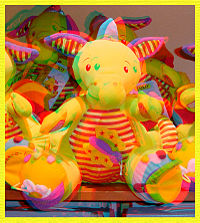
Scene composition
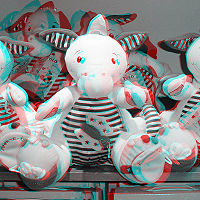
Dual purpose, 2D or 3D "compatible anaglyph" technique
Since the advent of the Internet, a variant technique has developed where the images are specially processed to minimize visible mis-registration of the two layers. This technique is known by various names, the most common, associated with diopter glasses, and warmer skin tones, is Anachrome. The technique allows most images to be used as large thumbnails, while the 3D information is encoded into the image with less parallax than conventional anaglyphs.Possible color schemes
Anaglyph images can use several possible color schemes (sometimes the eye colors are swapped). Under the principle of trichromacy, the three primary colorsPrimary Colors
Primary Colors: A Novel of Politics is a roman à clef, a work of fiction that purports to describe real life characters and events — namely, Bill Clinton's first presidential campaign in 1992...
of red, green, and blue act as the filters, and ideally, if the colors are to be mixed, the two eyes should not both have any of those colors, or else ghosting
Ghosting (television)
In television, a ghost is a replica of the transmitted image, offset in position, that is super-imposed on top of the main image on an analogue broadcast.-Common causes:Common causes of ghosts are:...
occurs. As such, there are only six possible combinations of colors possible for pure anaglyphs: red-green, red-blue, green-blue (extremely rare), red-cyan (green+blue), green-magenta (red+blue), or blue-yellow (red+green). Modern proprietary companies have developed schemes (many of which are patented or patent pending) that purposely integrate a limited amount of ghosting in one or both eyes that purportedly makes anaglyph images more pleasant to view, but these schemes generally remain based in one of the six basic combinations. In the cases of lighter colors being paired with darker ones (e.g. red-cyan, red-green or especially yellow-blue), the lighter color may need to be darkened, both to allow both eyes to work equally and to avoid introducing a possibly undesired Pulfrich effect
Pulfrich effect
The Pulfrich effect is a psychophysical percept wherein lateral motion of an object in the field of view is interpreted by the visual cortex as having a depth component, due to a relative difference in signal timings between the two eyes.-Overview:...
.
As different colors are rendered with fidelity depending on the used scheme, the choice of the proper color scheme is dictated by the image to be viewed. Retinal rivalry
Binocular rivalry
Binocular rivalry is a phenomenon of visual perception in which perception alternates between different images presented to each eye.When one image is presented to one eye and a very different image is presented to the other, instead of the two images being seen superimposed, one image is seen for...
can be reduced by lowering the color saturation of the scene, ghosting can be reduced by removing some of the opposite colors.
| scheme | left eye | L | R | right eye | color rendering | description |
|---|---|---|---|---|---|---|
| red-green | pure red | pure green | monochrome | the predecessor of red-cyan; ghosting on computer screens as the green filter lets too much red through. Used for printed materials, e.g. books and comics. | ||
| red-blue | pure red | pure blue | monochrome | no ghosting on screens as there is no overlap between the colors the filters let through. Often used for printed materials. | ||
| red-cyan | pure red | pure cyan (green+blue) | color (poor reds, good greens) | patent-free, limited color perception, currently the most common in use; images available in full version (red channel has only red color) and half version (red channel is a red-tinted grayscale image, yields worse colors but less retinal rivalry) | ||
| anachrome | dark red | cyan (green+blue+some red) | color (poor reds) | a variant of red-cyan; left eye has dark red filter, right eye has a cyan filter leaking some red; better color perception, can show red hues better than red-cyan | ||
| mirachrome | dark red+lens | cyan (green+blue+some red) | color (poor reds) | same as anachrome, with addition of a weak positive correction lens on the red channel to compensate for the chromatic aberration Chromatic aberration In optics, chromatic aberration is a type of distortion in which there is a failure of a lens to focus all colors to the same convergence point. It occurs because lenses have a different refractive index for different wavelengths of light... of eyes. |
||
| Trioscopic | pure green | pure magenta (red+blue) | color (better reds, oranges and wider range of blues than red/cyan) | Same principle as red-cyan, somewhat newer. Less chromatic aberration, as the red and blue in magenta balance well with green. | ||
| INFICOLOR | complex magenta | complex green | color (almost full and pleasant natural colors with excellent skin tones perception) | Developed by the TriOviz company, INFICOLOR 3D is a newer, patent pending stereoscopic system, first demonstrated at International Broadcast Convention International Broadcasting Convention The International Broadcasting Convention, more commonly known by its acronym IBC, is an annual trade show for broadcasters, content creators/providers, equipment manufacturers, professional and technical associations, and other participants in the Broadcasting industry... in 2007 and deployed in 2010. It works with traditional 2D screens and TV sets (LCD, Plasma) and uses glasses with brand new complex color filters and dedicated image processing Image processing In electrical engineering and computer science, image processing is any form of signal processing for which the input is an image, such as a photograph or video frame; the output of image processing may be either an image or, a set of characteristics or parameters related to the image... that allows a natural colors perception with a pleasant 3D experience. When observed without glasses only some slight doubling can be noticed in the background of the action which allows watching the movie in 2D without the glasses. This is not possible with traditional brute force anaglyphic systems. |
||
| ColorCode 3D ColorCode 3D ColorCode 3D is a newer, patented stereo viewing system deployed in the 2000s that uses amber and blue filters. Notably, unlike other anaglyph systems, ColorCode 3D is intended to provide perceived nearly full colour viewing with existing television and paint mediums.-Technology:One eye receives... |
amber (red+green+neutral grey) | pure dark blue (+optional lens) | color (almost full-color perception) | (also named yellow-blue, ochre-blue, or brown-blue) a newer system deployed in 2000s; better color rendering, but dark image, requires dark room or very bright image. Left filter darkened to equalize the brightness received by both eyes as the sensitivity to dark blue is poor. Older people may have problems perceiving the blue. Like in the mirachrome system, the chromatic aberration can be compensated with a weak negative correction lens (-0.7 diopter) over the right eye. Works best in the RG color space RG color space The RG or red-green color space is a color space that uses only two colors, red and green. It is an additive format, similar to the RGB color model but without a blue channel. Thus, blue is said to be out of gamut... . The weak perception of the blue image may allow watching the movie without glasses and not seeing the disturbing double-image. |
||
| magenta-cyan | magenta (red+blue) | cyan (green+blue) | color (better than red-cyan) | experimental; similar to red-cyan, better color rendering and less retinal rivalry. Blue channel is blurred horizontally by the amount equal to the average parallax, and visible to both eyes; the blurring prevents eyes from using the blue channel to construct stereoscopic image and therefore prevents ghosting, while supplying both eyes with color information. | ||
| Infitec Infitec Infitec GmbH is a German company that specializes in 3-dimensional technology. It owns a technique for channel separation in stereo projection based on interference filters... |
white (Red 629 nm, Green 532 nm, Blue 446 nm) | white (Red 615 nm, Green 518 nm, Blue 432 nm) | color (full color) | uses narrow-band interference filter Interference filter An interference filter or dichroic filter is an optical filter that reflects one or more spectral bands or lines and transmits others, while maintaining a nearly zero coefficient of absorption for all wavelengths of interest... s, requires corresponding interference filters for projectors, technical requirements comparable with polarization-based schemes. Not usable with standard CRT, LCD, etc. displays. |
||
In theory, under trichromatic principles, it is possible to introduce a limited amount of multiple-perspective capability (a technology not possible with polarization schemes). This is done by overlapping three images instead of two, in the sequence of green, red, blue. Viewing such an image with red-green glasses would give one perspective, while switching to blue-red would give a slightly different one. In practice, this remains rare. It is also theoretically possible to incorporate rod cell
Rod cell
Rod cells, or rods, are photoreceptor cells in the retina of the eye that can function in less intense light than can the other type of visual photoreceptor, cone cells. Named for their cylindrical shape, rods are concentrated at the outer edges of the retina and are used in peripheral vision. On...
s, which optimally perform at a dark cyan color, in well-optimized mesopic vision
Mesopic vision
Mesopic vision is a combination of photopic vision and scotopic vision in low but not quite dark lighting situations. Mesopic light levels range from luminances of approximately 0.001 to 3 cd m-2. Most night-time outdoor and traffic lighting scenarios are in the mesopic range.Humans see...
, to create a fourth filter color and yet another perspective; however, this has not yet been demonstrated, nor would most televisions be able to process such tetrachromatic filtering.
In DVD & Blu-ray Disc home release of theatrical 3D films
Disney Studios released Hannah Montana & Miley Cyrus: Best of Both Worlds ConcertHannah Montana & Miley Cyrus: Best of Both Worlds Concert
Hannah Montana & Miley Cyrus: Best of Both Worlds Concert is a 2008 American concert film from Walt Disney Pictures presented in Disney Digital 3-D. Released in the United States and Canada originally for one week, February 1–7, 2008, with release in other countries later on...
in August 2008, its first anaglyph 3D Blu-ray Disc
Blu-ray Disc
Blu-ray Disc is an optical disc storage medium designed to supersede the DVD format. The plastic disc is 120 mm in diameter and 1.2 mm thick, the same size as DVDs and CDs. Blu-ray Discs contain 25 GB per layer, with dual layer discs being the norm for feature-length video discs...
. This was shown on the Disney Channel
Disney Channel
Disney Channel is an American basic cable and satellite television network, owned by the Disney-ABC Television Group division of The Walt Disney Company. It is under the direction of Disney-ABC Television Group President Anne Sweeney. The channel's headquarters is located on West Alameda Ave. in...
with red-cyan paper glasses in July 2008.
The greater clarity of Blu-ray Disc, and the learning curve at Disney, has greatly improved red-cyan anaglyph, especially in relation to close overlay of the 3D images, such as they have followed in their animation projects. Most Disney theatrical 3D images show far less mal-registration, compared to old-fashioned polarized or anaglyph technique.
In comics
These techniques have been used to produce 3-dimensional comic bookComic book
A comic book or comicbook is a magazine made up of comics, narrative artwork in the form of separate panels that represent individual scenes, often accompanied by dialog as well as including...
s, mostly during the early 1950s, using carefully constructed line drawings printed in colors appropriate to the filter glasses provided. The material presented were typically short graphic novels of a war story, horror, or crime/detective nature, similar in content to some modern Japanese manga
Manga
Manga is the Japanese word for "comics" and consists of comics and print cartoons . In the West, the term "manga" has been appropriated to refer specifically to comics created in Japan, or by Japanese authors, in the Japanese language and conforming to the style developed in Japan in the late 19th...
. These genres were largely eliminated in the US by the rise of the Comics Code Authority
Comics Code Authority
The Comics Code Authority was a body created as part of the Comics Magazine Association of America, as a tool for the comics-publishing industry to self-regulate the content of comic books in the United States. Member publishers submitted comic books to the CCA, which screened them for adherence to...
. Anaglyphed images were of little interest for use in the remaining comics, which emphasized bright and colorful images, unsuited for use with the viewing and production methods available at the time, which were usually red-green rather than red-cyan.--
In science and mathematics

Also, chemical structures, particularly for large systems, can be difficult to represent in two dimensions without omitting geometric information. Therefore most chemistry computer software can output anaglyph images, and some chemistry textbooks include them.
Today, there are more advanced solutions for 3D imaging available, like shutter glasses together with fast monitors. These solutions are already extensively used in science. Still, anaglyph images provide a cheap and comfortable way to view scientific visualizations.
Other
On April 1, 2010, GoogleGoogle
Google Inc. is an American multinational public corporation invested in Internet search, cloud computing, and advertising technologies. Google hosts and develops a number of Internet-based services and products, and generates profit primarily from advertising through its AdWords program...
launched a feature in Google Street View
Google Street View
Google Street View is a technology featured in Google Maps and Google Earth that provides panoramic views from various positions along many streets in the world...
that shows anaglyphs rather than regular images, allowing users to see the streets in 3D.
See also
- HolographyHolographyHolography is a technique that allows the light scattered from an object to be recorded and later reconstructed so that when an imaging system is placed in the reconstructed beam, an image of the object will be seen even when the object is no longer present...
- ImageVis3DImageVis3DImageVis3D is a lightweight, open source, volume rendering application for the interactive visualization of very large volumetric data sets. It utilizes both the slice based as well as the GPU ray casting approach to visualize the volume data...
- PhantogramPhantogramPhantograms, also known as Phantaglyphs, Op-Ups, free-standing anaglyphs, levitated images, and book anaglyphs, are a form of optical illusion. Phantograms use perspectival anamorphosis to produce a 2D image that is distorted in a particular way so as to appear, to a viewer at a particular vantage...
- Pulfrich effectPulfrich effectThe Pulfrich effect is a psychophysical percept wherein lateral motion of an object in the field of view is interpreted by the visual cortex as having a depth component, due to a relative difference in signal timings between the two eyes.-Overview:...
- StereogramStereogramA stereogram is pair of two-dimensional panels depicting the view of a scene or an object from the vantage points of the right and left eyes. Observing the panels superimposed in a stereoscope results in the experience of three-dimensionality by virtue of the fact that object depth is encoded as...
- VectographVectographA vectograph is a type of stereoscopic print or transparency viewed using the polarized 3D glasses most commonly associated with projected three-dimensional motion pictures....
- Wheatstone viewer
External links
- The Stereoscopic 3D Channel on Vimeo
- Phereo: Stereo Photo Sharing Website - enables stereo image conversion from/to anaglyph format
- 1000 High Quality 3D images of South America - Images viewable as 3D anaglyphs or parallel images
- TIM - Online raytracer that also generates anaglyphs (for red/blue glasses) and autostereograms

